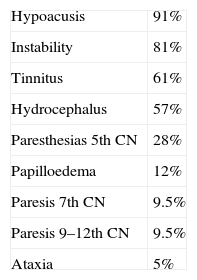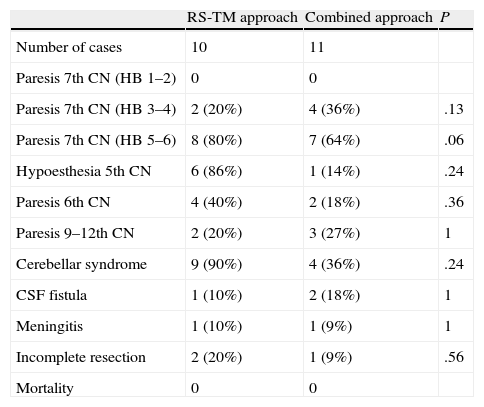To compare the results obtained in the resection of 21 giant vestibular schwannomas via retrosigmoid (RS) and combined retrosigmoid/translabyrinthine (RS/TL) approaches with respect to intra- and postoperative complications, facial nerve preservation and postsurgical sequelae.
MethodsThis was a retrospective study of 21 patients who underwent a resection of a giant vestibular neuroma according to the Tos & Thomsen Scale (greater than or equal to 4cm) in a tertiary care centre in the period between 2000 and 2008. We present the most significant characteristics of the series studied and the analysis of the advantages and inconveniences of each approach. We also analyse the results regarding facial nerve function preservation.
ResultsWe highlight the absence of mortality in the 21-patient group. There were no important intraoperative complications. Total resection of the lesion was achieved in the 87% of the cases, with facial nerve preservation of 73% using the combined RS/TL approach, in comparison to 40% using the RS. Facial nerve function after two years was acceptable or good in 67% (including those with heteronerve anastomosis). A global percentage of 14.3% of cerebrospinal liquid fistula was observed, as well as 9.5% of meningitis.
ConclusionsThe results of the study demonstrate that the combined retrosigmoid translabyrinthine approach for giant schwannoma treatment offers increased facial nerve preservation and lower morbidity, constituting an important option in the treatment of this kind of tumours thanks to a multidisciplinary approach.
Comparar los resultados obtenidos en la resección de 21 schwanomas vestibulares gigantes, mediante vía retrosigmoidea y combinada retrosigmoidea/translaberíntica en cuanto a complicaciones intra y postoperatorias, preservación del nervio facial y secuelas posquirúrgicas.
MétodosSe realiza un estudio retrospectivo de 21 pacientes a los que se practicó resección de neurinoma vestibular gigante según la escala de Tos & Thomsen (igual o mayor a 4cm), en un hospital de tercer nivel en el periodo entre 2000 y 2008. Se presentan las características más significativas de la serie estudiada, y se analizan las ventajas e inconvenientes de los distintos abordajes, comparando los resultados obtenidos. Asimismo, se analizan los resultados en cuanto a la preservación de la función del nervio facial.
ResultadosDestaca la ausencia de mortalidad en el grupo de 21 pacientes estudiado. No hubo complicaciones intraoperatorias importantes. Se consiguió la resección total de la lesión en el 87% de los casos, con una preservación anatómica del nervio facial del 73% en el abordaje combinado retrosigmoideo/translaberíntico, respecto a un 40% en el retrosigmoideo. La función del nervio facial a los dos años fue aceptable o buena en un 67% (incluyendo los resultados de las anastomosis heteronerviosas). Se observó un porcentaje global del 14,3% de fístula de líquido cefalorraquídeo y un 9,5% de meningitis.
Conclusionesnuestros resultados demuestran que el abordaje combinado retrosigmoideo translaberíntico para el tratamiento de schwannomas gigantes ofrece mayor preservación del nervio facial y disminución de la morbilidad, siendo una importante opción en el tratamiento de estos tumores, gracias a un enfoque multidisciplinar.
Artículo
Comprando el artículo el PDF del mismo podrá ser descargado
Precio 19,34 €
Comprar ahora







